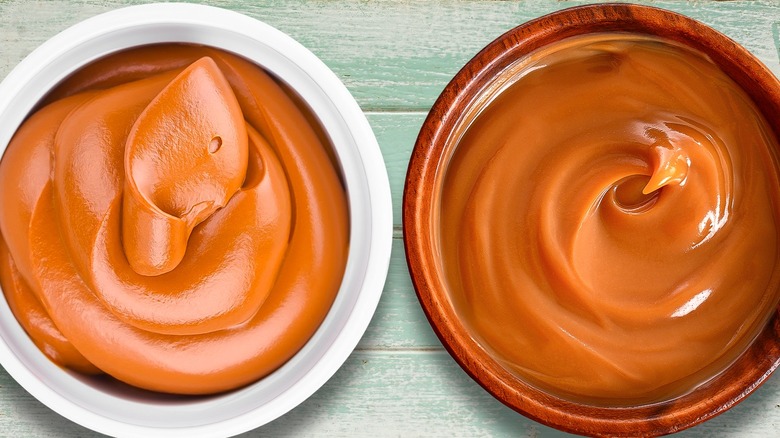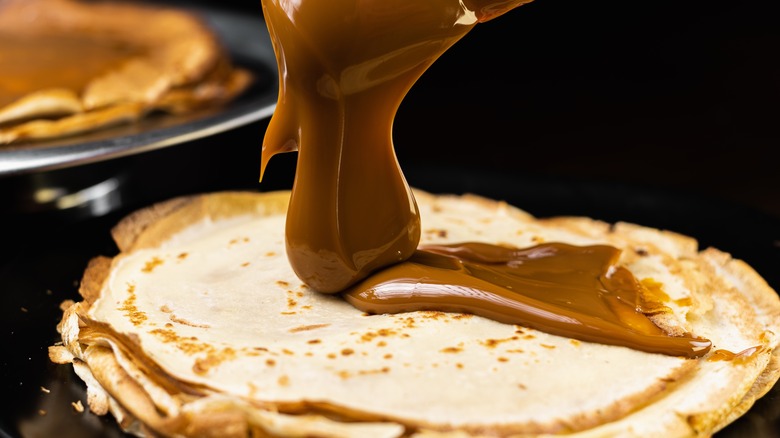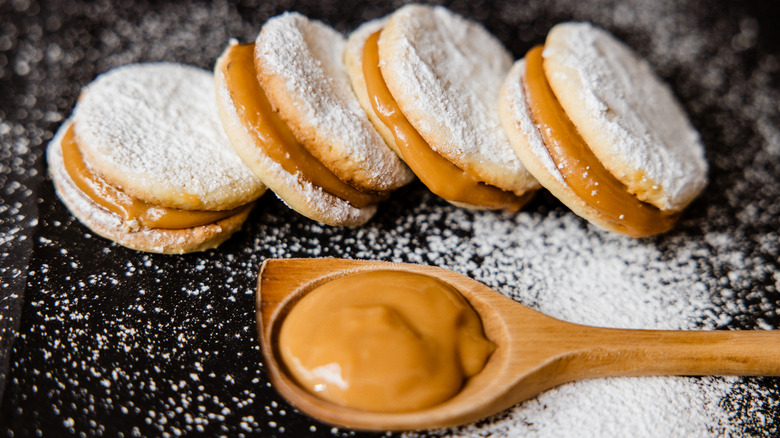Manjar Vs Dulce De Leche: Is There A Difference?
Something magical happens when you combine milk and sugar and cook it low and slow. As the milk evaporates and the sugar caramelizes, it creates a thick sauce with a rich flavor. You'll probably know this as dulce de leche, which has graced Instagrammable desserts across the U.S., including Christina Tosi's dulce de leche layer cake and Crumbl cookies. But if you find yourself in Chile, you'll see this milk caramel referred to as manjar.
So, is manjar just dulce de leche by another name? Most accounts will tell you yes, that it's just the name that changes depending on the country — dulce de leche in Spain and Argentina, manjar in Chile, manjar blanco in Peru, and arequipe in Colombia and Venezuela. But ask any Chilean and they will probably have some strong thoughts on the issue. Some say manjar is creamier, thicker, and richer, while dulce de leche is lighter and sweeter, but the truth is that recipes vary by brand, region, and family.
What is manjar?
Regardless of which side of the debate you take, manjar (meaning "delicacy") is the Chilean version of the sweet filling made from cooking down milk and sugar over several hours. Some recipes add a little vanilla essence, and a pinch of baking soda to help the manjar develop a deep brown color. The "quick" version involves boiling an unopened can of sweetened condensed milk for two hours, though you can use a pressure cooker to speed this up.
Manjar is essential to Chilean desserts like the thousand-layer cake, but it can be eaten at any time of day. It's a popular topping for bread at breakfast, it's rolled inside pancakes as a snack, and it can be served alongside cheese, fruit, or cookies. And although it won't be advertised, there is a Chilean recipe that involves adding cannabis to the mix.
In Peru, this caramel is called manjar blanco, but if you use that name in Spain, you'll be presented with a kind of milk pudding similar to blancmange. To add to the confusion, milk pudding is known as manjar de leche in Guatemala.
What is dulce de leche?
Dulce de leche is undoubtedly the most famous of the two names (or preparations). The sweet is most closely associated with Argentina, where, according to Google Arts & Culture, they eat an average of seven pounds of it per person each year. With written records dating back to 1829 in Buenos Aires, Argentinians like to claim dulce de leche as their own invention, but historian Daniel Balmaceda says it's more likely to have originated in Indonesia, then made its way to the Philippines and later to Latin America with the Spanish conquistadors.
As with manjar in Chile, dulce de leche is used as a filling for desserts and pastries right across South America. The Argentinians use it in their beloved alfajores cookies and chocotorta, while in Peru it's sandwiched between layers of meringue for a heady sugar hit. It's also perfectly acceptable to eat it straight out of the jar with a spoon. For countries that use the name dulce de leche, you'll also find some variations in recipes. In Cuba, it's often made with curdled milk and flavored with citrus and cinnamon, while in the Dominican Republic, it's set into molds to create a fudge-like sweet.
Regardless of what you call it at home, if you can agree to the name dulce de leche just one day of the year, make it October 11. Since 1995 this has been International Dulce de Leche Day, and is the perfect chance to celebrate this sweet in all its forms.


